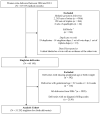Accuracy of ICD-9-CM coding to identify small for gestational age newborns
- PMID: 25656656
- PMCID: PMC4533984
- DOI: 10.1002/pds.3740
Accuracy of ICD-9-CM coding to identify small for gestational age newborns
Abstract
Purpose: This study aimed to evaluate the accuracy of the International Classification of Diseases, Ninth Revision, Clinical Modification (ICD-9-CM) diagnosis code for small for gestational age (SGA) recorded in administrative healthcare records using birthweight and gestational age information recorded in electronic medical records.
Methods: We used billing and medical records from women aged 13-55 years who delivered at a tertiary care center in the USA between 2004 and 2011. Information on birthweight, gestational age at birth, and ICD-9-CM code for SGA, 656.5x, was abstracted from the database. Each infant's birthweight percentile for gestational age was calculated on the basis of published US references; infants below the 10th percentile were classified as SGA. The performance characteristics of SGA ICD-9-CM diagnosis code against SGA classification based on birthweight and gestational age were calculated, for all deliveries and by strata of demographic and delivery characteristics.
Results: We identified 51 292 singleton live birth deliveries. The prevalence of SGA infants calculated from birthweight and gestational age at birth was higher (13%) than the prevalence based on ICD-9-CM code (2%). Sensitivity of the SGA ICD-9-CM code was 14.2%, specificity was 99.7%, positive predictive value was 86.8%, and negative predictive value was 88.4%. Stratification by demographic and delivery characteristics yielded similar results.
Conclusions: Identification of SGA infants using ICD-9-CM code, 656.5x, from administrative healthcare records has low sensitivity but high specificity; the accuracy did not differ across demographic and delivery characteristics. Thus, although this source of information would underestimate the prevalence of SGA, it could produce valid relative risk estimates.
Keywords: ICD-9-CM codes; gestational age; healthcare records; pharmacoepidemiology; sensitivity; small for gestational age; specificity.
Copyright © 2015 John Wiley & Sons, Ltd.
Figures


Similar articles
-
Use of International Classification of Diseases, Ninth Revision, Clinical Modification codes and medication use data to identify nosocomial Clostridium difficile infection.Infect Control Hosp Epidemiol. 2009 Nov;30(11):1070-6. doi: 10.1086/606164. Infect Control Hosp Epidemiol. 2009. PMID: 19803724
-
Comparison of US Birth Weight References and the International Fetal and Newborn Growth Consortium for the 21st Century Standard.JAMA Pediatr. 2015 Jul;169(7):e151438. doi: 10.1001/jamapediatrics.2015.1438. Epub 2015 Jul 6. JAMA Pediatr. 2015. PMID: 26147059
-
Validation of Diagnosis Codes for Low Birth Weight and Small-for-Gestational Age in the Medicaid Analytic Extract Database.Am J Epidemiol. 2025 Jan 14:kwae472. doi: 10.1093/aje/kwae472. Online ahead of print. Am J Epidemiol. 2025. PMID: 39814679
-
Health outcomes coding trends in the US Food and Drug Administration's Sentinel System during transition to International Classification of Diseases-10 coding system: A brief review.Pharmacoepidemiol Drug Saf. 2021 Jul;30(7):838-842. doi: 10.1002/pds.5216. Epub 2021 Mar 17. Pharmacoepidemiol Drug Saf. 2021. PMID: 33638243 Free PMC article. Review.
-
Validity of International Classification of Diseases codes in identifying illicit drug use target conditions using medical record data as a reference standard: A systematic review.Drug Alcohol Depend. 2020 Mar 1;208:107825. doi: 10.1016/j.drugalcdep.2019.107825. Epub 2019 Dec 23. Drug Alcohol Depend. 2020. PMID: 31982637 Free PMC article.
Cited by
-
Emulating a target trial of the comparative effectiveness of clomiphene citrate and letrozole for ovulation induction.Hum Reprod. 2022 Apr 1;37(4):793-805. doi: 10.1093/humrep/deac005. Hum Reprod. 2022. PMID: 35048945 Free PMC article.
-
Development and Validation of ICD-10-CM-based Algorithms for Date of Last Menstrual Period, Pregnancy Outcomes, and Infant Outcomes.Drug Saf. 2023 Feb;46(2):209-222. doi: 10.1007/s40264-022-01261-5. Epub 2023 Jan 19. Drug Saf. 2023. PMID: 36656445 Free PMC article.
-
Small for Gestational Age Coded Diagnoses in Aotearoa New Zealand's Administrative Health Datasets: A Validation Study.Health Sci Rep. 2025 Apr 30;8(5):e70610. doi: 10.1002/hsr2.70610. eCollection 2025 May. Health Sci Rep. 2025. PMID: 40309634 Free PMC article.
-
Atovaquone-proguanil exposure in pregnancy and risk for adverse fetal and infant outcomes: A retrospective analysis.Travel Med Infect Dis. 2019 Nov-Dec;32:101519. doi: 10.1016/j.tmaid.2019.101519. Epub 2019 Nov 17. Travel Med Infect Dis. 2019. PMID: 31747537 Free PMC article.
-
Ischemic Placental Disease, Preterm Delivery, and Their Association With Opioid Use During Pregnancy.Am J Epidemiol. 2022 Mar 24;191(5):759-768. doi: 10.1093/aje/kwab132. Am J Epidemiol. 2022. PMID: 34165143 Free PMC article.
References
-
- Carberry AE, Gordon A, Bond DM, Hyett J, Raynes-Greenow CH, Jeffery HE. Customised versus population-based growth charts as a screening tool for detecting small for gestational age infants in low-risk pregnant women. Cochrane Database Syst Rev. 2011;(12):CD008549. doi:CD008549. - PubMed
-
- Saenger P, Czernichow P, Hughes I, Reiter EO. Small for gestational age: short stature and beyond. Endocr Rev. 2007;28:219–251. - PubMed
-
- Luyckx VA, Bertram JF, Brenner BM, et al. Effect of fetal and child health on kidney development and long-term risk of hypertension and kidney disease. Lancet. 2013;382:273–283. - PubMed
-
- Lim G, Tracey J, Boom N, et al. CIHI survey: Hospital costs for preterm and small-for-gestational age babies in Canada. Healthc Q. 2009;12:20–24. - PubMed
Publication types
MeSH terms
Grants and funding
LinkOut - more resources
Full Text Sources
Other Literature Sources

